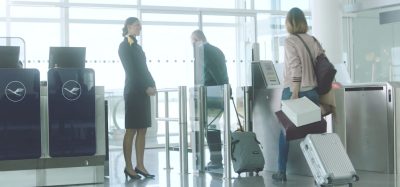Technology drives customer service at Halifax Stanfield International Airport
- Like
- Digg
- Del
- Tumblr
- VKontakte
- Buffer
- Love This
- Odnoklassniki
- Meneame
- Blogger
- Amazon
- Yahoo Mail
- Gmail
- AOL
- Newsvine
- HackerNews
- Evernote
- MySpace
- Mail.ru
- Viadeo
- Line
- Comments
- Yummly
- SMS
- Viber
- Telegram
- Subscribe
- Skype
- Facebook Messenger
- Kakao
- LiveJournal
- Yammer
- Edgar
- Fintel
- Mix
- Instapaper
- Copy Link
Posted: 1 February 2018 | Craig Paul (HIAA) | No comments yet
Halifax Stanfield International Airport is well known for its hospitality and customer service, consistently ranking among the best airports in the world. In an interview for International Airport Review, Halifax International Airport Authority’s Craig Paul, Director of Business Solutions and Information Technology, explains that the foundation of the airport’s approach is ‘The Stanfield Way’ – a distinctive airport service culture programme.
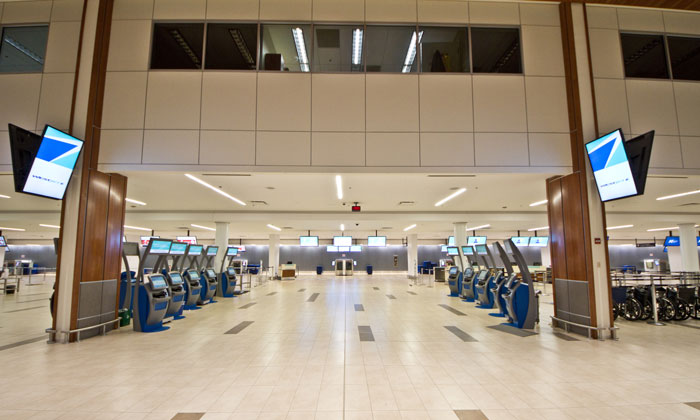

Check-in kiosks at Halifax Stanfield
“Airports are emotional places,” says Craig. “We never want to lose sight of that, so we have embraced a culture of superior service and work hard to make Halifax Stanfield a place where everyone feels welcome, relaxed and safe, every day. And it’s a community effort.”
A big part of that commitment to customer service is utilising the latest and greatest technology available, and Atlantic Canada’s largest airport has a long-standing history of being an early adopter of technology to improve the passenger experience.
Halifax International Airport Authority (HIAA) is the locally controlled, non-share capital corporation that manages and operates Halifax Stanfield. Entrenched in its strategic plan is a focus on both customer service and technology.
“We identified customer-service culture as one of our four foundation elements and maximising airport efficiency as a strategic priority,” says Craig. “Formalising our commitment to efficiency through technology in this way ensures we will have the resources we need to succeed.”
And Halifax Stanfield has a made a little history along the way.
“In 2007, we were the first major airport in Canada to provide free wireless internet services in our terminal building,” says Craig. But that was only the beginning.
First moving sidewalks
In 2009, Halifax Stanfield opened a new parking structure, and with it Nova Scotia’s first moving sidewalks connected it to the terminal building.
“This addition to our facility provides easier and faster access to and from our Parkade,” says Craig. “Travellers, especially those with mobility issues, have the highest level of service at the airport.”
To make way for the new vertical circulation components in the terminal building, the old escalators were replaced. What makes that noteworthy is that they too were trailblazing. After almost half a century of service, and millions of revolutions, Nova Scotia’s first escalators were retired.
Self-service baggage – a first in North America
In 2014, Halifax Stanfield became the first airport in North America to offer self-service baggage drop for all passengers.
The new, fully automated, self-service baggage drop system utilised the latest technology to simplify the check-in process for airline passengers. This improved level of service speeded up the check-in process and reduced the time spent in queues.
HIAA worked closely with its airline partners to develop this new passenger processing model.
Similar self-service processes had been in use by some airlines in airports in other areas of the world. “We saw this as an opportunity to be an industry leader, offering an enhanced, time-saving service to our passengers,” says Craig.
The new baggage drop system was part of a larger project that saw modernisation of the baggage handling and screening equipment and renovations to the terminal building, to upgrade and expand both the domestic/international and U.S. preclearance check-in halls.
New baggage handling system
A new, state-of-the-art baggage handling system was also installed. Its space-saving design delivered higher capacity, more sophisticated baggage handling capabilities, and the latest baggage screening technology for domestic, international, and U.S.-bound passengers.
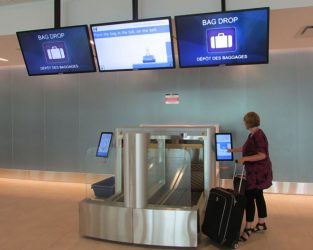

Self-serve baggage drop is available at Halifax Stanfield
“We worked collaboratively with our baggage system contractor, Buemer Group, the Canadian Air Transport Security Authority, and U.S. Customs and Border Protection to install this new state-of-the-art system,” says Craig. “With increased capacity, enhanced safety and security, and improved efficiency,
this system will serve us well for years to come.”
Impressively, the fully-automated system cuts the average check-in time from about 10 minutes to less than two. With almost two million departing passengers checking two million pieces of luggage through the airport annually, those reduced waiting times are saving passengers thousands of hours – time they can use to shop, read or simply relax.
The airport’s position as an industry leader was recognised when it received a national Ingenious Award. The baggage system was named one of Canada’s most innovative technology achievements in 2014 by the Information Technology Association of Canada.
Renovated terminal building
Both the domestic/international and U.S. preclearance check-in halls were renovated at the same time to create more room for passenger flow, new equipment and processes, and future growth.
At the domestic/international check-in end of the terminal building, a contemporary look for the building exterior has altered the airport landscape. The two-story glass façade brought natural light into the space with architecture that was consistent with the rest of the terminal.
All of these improvements were part of HIAA’s long-term capital plan. “As a key driver in regional economic growth, it’s vital to ensure Halifax Stanfield continues to meet the needs of our current and future passengers and visitors, and adapts to the ongoing requirements of our airline partners,” says Craig.
ABOUT HALIFAX STANFIELD’S SELF-SERVICE BAGGAGE DROP SYSTEM, JON QUINTON, STATION MANAGER FOR WESTJET IN HALIFAX, COMMENTED:
“We welcome any airport improvements that enrich the travel experience for our guests. The new system helps travellers move through the check-in process more quickly, and frees up our team members to get out from behind the counters and assist those guests who need a little extra attention.”
Quicker at the border
In 2016, seven BorderXpress Automated Passport Control (APC) kiosks were installed in the U.S. preclearance area at Halifax Stanfield. The new kiosks help U.S. Customs and Border Protection officers process more passengers than traditional clearance methods, reducing congestion and decreasing waiting times.
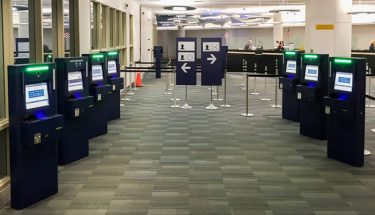

BorderXpress Automated Passport Control (APC) kiosks at Halifax Stanfield
The new kiosks are both secure and efficient. By automating the administrative portion of the U.S. Customs and Border Protection process, the APC technology makes the process speedy and smooth for passengers.
Passengers proceed directly to a self-service kiosk in the U.S. Customs and Border Protection area, follow the on-screen instructions to scan their passport and answer customs declaration questions, then receive a receipt confirming their information and continue to a U.S. Customs and Border Protection officer to finalise processing.
In October 2017, the Canada Border Services Agency (CBSA) introduced similar technology and benefits for passengers entering or returning to Canada with 24 Primary Inspection Kiosks (PIK) and an eDeclaration mobile app. The kiosks are next generation technology that offer self-service options for international air travellers arriving in Canada at Halifax Stanfield.
Much like the APC kiosk process at U.S. Customs, passengers proceed directly to the PIK kiosks to verify travel documents and complete an on-screen declaration. PIK also uses facial authentication (involving a one-to-one photo comparison at the kiosk with the traveller’s passport) to confirm identity. Those
looking to save more time can complete their declaration in advance using the CanBorder – eDeclaration mobile app, which will give them a quick response code to scan at a kiosk upon arrival. Halifax Stanfield was the fifth Canadian airport to launch the PIK technology in 2017.
Craig says: “We are continuously looking for innovative ways to improve the airport experience of our passengers. We were delighted to collaborate with Canada Border Services Agency and launch this enhancement for the benefit of returning residents and arriving visitors.”
TRAX® SmartRestroom
In October 2017, Halifax Stanfield became the first Canadian airport to implement an Infax TRAX® SmartRestroom system.
“This new system is helping us continue to deliver on its commitment to superior customer experience through early adoption of innovative technologies,” explains Craig.
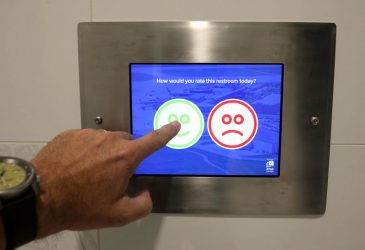

The TRAX® SmartRestroom system helps deliver superior customer experience
The pilot solution includes throughput counting, predictive data, cleaning alerts and customer survey tablets, which are located at the exit of the two washrooms in domestic arrivals.
The SmartRestroom user interface allows the airport to view survey results and real-time passenger analytics. Airport Authority staff can see feedback left by passengers and immediately take care of the problem before it escalates.
Craig adds: “We are very pleased with the quality of data we are receiving from the TRAX® SmartRestroom solution. Having a system that provides both real-time and predictive data is a key differentiator for improving our operational efficiency and managing washroom cleanliness.”
Halifax Stanfield’s pilot system marked the sixth SmartRestroom project for Infax. With more projects in the works and plans for system expansion, the solution is proving to be a revolutionary tool for improving business operations and the customer experience.
What’s next?
“As part of our ongoing commitment to improve collaboration and communication within our organisation, we have launched a new project to refresh our traditional data file management and employee intranet by adopting Microsoft Office 365 services and SharePoint,” says Craig.
Enterprise Content Management (ECM) is a formalised means of organising and storing an organisation’s documents, images, records, videos and other content that relate to the organisation’s processes. The term encompasses strategies, methods and tools used throughout the lifecycle of the organisation’s content.
Halifax Stanfield offers the very best in facilities and services to its passengers and visitors by employing the latest technology.
Craig finishes: “The only way to create the airport of tomorrow – our ultimate goal – is with the technology of the future. We’re proud to bring industry-leading processes to Halifax Stanfield and believe they are a testament to our customer service commitment.”


Issue
Related topics
Baggage handling, Border control, ePassports, Passenger experience and seamless travel, Security, Terminal operations



